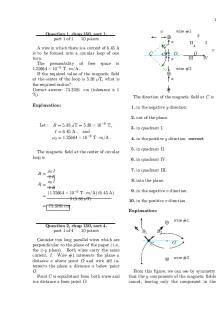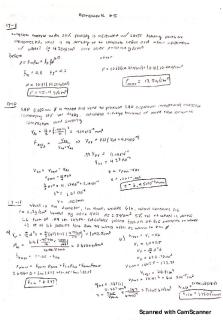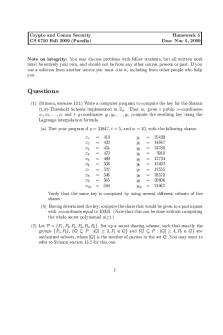Unit 5 Homework PDF

| Title | Unit 5 Homework |
|---|---|
| Course | Business Ethics |
| Institution | Park University |
| Pages | 3 |
| File Size | 121.3 KB |
| File Type | |
| Total Downloads | 14 |
| Total Views | 136 |
Summary
Homework...
Description
Fernando Castro
MBA524 Homework – Unit 5
Page: 1
Answer: Chapter 13 - Questions 4, 5, 7. Question 4: Discuss the theories Mr. Ruvolo might use for recovery and who the defendants might be. Answer: Mr. Ruvolo would use the Food and Drink Merchantability case for recovery. While the foreignnatural doctrine would normally mean that Taco Bell and the Food Distributors are not liable for damages caused by these objects, there is also a “reasonable expectations” test that applied. This test provides that “regardless whether a substance in a food product is natural to an ingredient thereof, liability will lie for injuries caused by the substance where the consumer of the product would not reasonably have expected to find the substance in the product” (Jennings, 2016, p. 463). Mr. Ruvolo should sue both Taco Bell as they served the product, and the company who makes/packages the product, as they were the ones who should’ve first discovered the foreign matter in the food he ate. Question 5: Could there be remedies for the design of the physical equipment used with computers? Answer: Yes, this might fall under the Implied Warranty of Fitness for a Particular Purpose. Since the seller is promising that the goods are going to be suitable for the way the buyer will use them, the fact that Nintendo’s controllers would slip out of people’s hands and cause injuries or damages means that they are not suitable for that purpose. They might also be able to find a remedy through the Requirement of Unreasonably Dangerous Defective Condition. Under this condition, the Improper Warnings and Instructions test states that “Manufacturers have a duty to warn buyers of a foreseeably dangerous use of a product that the buyers are not likely to realize is dangerous” (Jennings, 2016, p. 468). Question 7: Should she recover? Answer: No, Ms. Hubbs should not be able to recover. There was no defect present in the Clapper she purchased and the manufacturer had specifically stated that it had an adjustment for sensitivity, which Ms. Hubbs admitted she knew about. Further, they advise of a clicker device that can be used instead of clapping your hands, which she also knew about. Jennings informs us that the implied warranty of merchantability only covers goods that are of fair or good quality and are fit for their ordinary purposes. The Clapper clearly demonstrates that they did not violate this implied warranty. Even though they were not responsible, Mclachlan shows us how this case led The Clapper to add a warning stipulating “you don’t have to clap very hard” on their instructions going forward.
Answer: Chapter 14 - Case 14.1 Brief Case 14.1 Brief The case deals with a shopping center who decided to rent some empty retail space to a an LLC called JTF, who then used the floor space for a flea market and an Amish market. This shopping center already had a grocery store, Redner’s, which had a contract with the shopping center stipulating that there would be no competition in the form of other competing grocery stores (this is called a restrictive covenant). The shopping center even agreed to take on any legal action from Redner’s and indemnify
Fernando Castro
MBA524 Homework – Unit 5
Page: 2
JTF in any legal actions. Redner’s sued alleging a violation of the restrictive covenant. The court decided that it couldn’t judge the Amish market as a whole, as it didn’t meet the legal requirements of a retail operator, so it decided to rule on each individual stall. In the end, five of the eight stalls were found to violate the restrictive covenant. Question 1: Explain why the Amish Farmer’s Market is not a violation of the restrictive covenant against Redner’s. Answer: The judgement states that the contract specifically mentions “retail operator” and this can only apply to each individual stall, not to the market as a whole. Question 2: What are the key factors the court uses in evaluating each of the stall stores? Answer: The court looks at what each individual stall sells and breaks it down into categories. The court then fits these categories into the Restrictive Covenant and the exceptions therein to judge whether they violate the contract or not. Question 3: What lessons can landlords and tenants learn from this dispute? Answer: Landlords can learn that their contracts will be enforced and they must do their due diligence to protect themselves from violating the terms therein. Tenants also need to be wary of any contracts their actions might violate, even if they are not in their specific contract with the landlord.
Answer questions, Questions 2, 3, 10. Question 2: Are there any antitrust issues with this requirement? Answer: Yes, there are. By requiring that all POD authors use one company, they are artificially limiting the market and creating a monopoly. Since they also own that company, it makes it even worse. They have clearly established exclusionary conduct. Jennings (Jennings, 2016) defines exclusionary conduct as actions a company takes in order to prevent any potential competitors from participating in the market. Question 3: Has there been a violation of the antitrust laws? Answer: Yes, this would fall under Group Boycotts and Refusals to Deal because this has an anticompetitive effect of controlling the marketplace (Jennings, 2016, p. 502). Question 10: Who is correct on the noncompetition agreement? Is it valid? Why or why not? Answer: SAS is correct in their agreement with Barnes and the clause is valid. Noncompetition agreements are just a restrictive covenant and are valid as long as they are reasonable in length and scope (Jennings, 2016, p. 487). Since Barnes was competing at the same trade show SAS was at, this limits the scope to a small geographic area.
Please see Reference Page below.
Fernando Castro
MBA524 Homework – Unit 5
Page: 3
References Jennings, Marianne. 2016. Business: It's Legal, Ethical and Global Environment (11th ed.). Boston, MA: Cengage Learning. MCLACHLAN, J. (2011, March 29). Why Warning Labels Are So Damn Dopey. Retrieved from https://www.wired.com/2011/03/st_warninglabels/...
Similar Free PDFs

Unit 5 Homework
- 3 Pages

Unit 3 homework - unit 3
- 4 Pages

Homework 5
- 2 Pages

Homework 5
- 9 Pages

Homework 5
- 4 Pages

Hoework 5 - homework 5
- 3 Pages

Homework 5
- 2 Pages

Unit 7 Homework- Chatterley
- 3 Pages

Unit 7 homework
- 7 Pages

English homework unit 1
- 1 Pages

HW 5 - Week 5 homework
- 6 Pages

Unit 5
- 9 Pages

Chapter 5 HW - Homework
- 2 Pages

5 - online homework solution
- 8 Pages

Seminar assignments - Homework 5
- 1 Pages
Popular Institutions
- Tinajero National High School - Annex
- Politeknik Caltex Riau
- Yokohama City University
- SGT University
- University of Al-Qadisiyah
- Divine Word College of Vigan
- Techniek College Rotterdam
- Universidade de Santiago
- Universiti Teknologi MARA Cawangan Johor Kampus Pasir Gudang
- Poltekkes Kemenkes Yogyakarta
- Baguio City National High School
- Colegio san marcos
- preparatoria uno
- Centro de Bachillerato Tecnológico Industrial y de Servicios No. 107
- Dalian Maritime University
- Quang Trung Secondary School
- Colegio Tecnológico en Informática
- Corporación Regional de Educación Superior
- Grupo CEDVA
- Dar Al Uloom University
- Centro de Estudios Preuniversitarios de la Universidad Nacional de Ingeniería
- 上智大学
- Aakash International School, Nuna Majara
- San Felipe Neri Catholic School
- Kang Chiao International School - New Taipei City
- Misamis Occidental National High School
- Institución Educativa Escuela Normal Juan Ladrilleros
- Kolehiyo ng Pantukan
- Batanes State College
- Instituto Continental
- Sekolah Menengah Kejuruan Kesehatan Kaltara (Tarakan)
- Colegio de La Inmaculada Concepcion - Cebu
